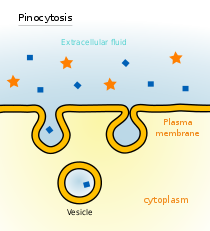
Pinocytosis
Encyclopedia

Endocytosis
Endocytosis is a process by which cells absorb molecules by engulfing them. It is used by all cells of the body because most substances important to them are large polar molecules that cannot pass through the hydrophobic plasma or cell membrane...
in which small particles are brought into the cell—forming an invagination, and then suspended within small vesicles
Vesicle (biology)
A vesicle is a bubble of liquid within another liquid, a supramolecular assembly made up of many different molecules. More technically, a vesicle is a small membrane-enclosed sack that can store or transport substances. Vesicles can form naturally because of the properties of lipid membranes , or...
that subsequently fuse with lysosome
Lysosome
thumb|350px|Schematic of typical animal cell, showing subcellular components. [[Organelle]]s: [[nucleoli]] [[cell nucleus|nucleus]] [[ribosomes]] [[vesicle |vesicle]] rough [[endoplasmic reticulum]]...
s to hydrolyze, or to break down, the particles. This process requires a lot of energy in the form of adenosine triphosphate
Adenosine triphosphate
Adenosine-5'-triphosphate is a multifunctional nucleoside triphosphate used in cells as a coenzyme. It is often called the "molecular unit of currency" of intracellular energy transfer. ATP transports chemical energy within cells for metabolism...
, the chemical compound used as energy in the majority of cells. Pinocytosis is used primarily for the absorption of extracellular fluids (ECF), and, in contrast to phagocytosis, generates very small vesicles. Unlike receptor-mediated endocytosis
Receptor-mediated endocytosis
Receptor-mediated endocytosis , also called clathrin-dependent endocytosis, is a process by which cells internalize molecules by the inward budding of plasma membrane vesicles containing proteins with receptor sites specific to the molecules being internalized.-Process:After the binding of a...
, pinocytosis is nonspecific in the substances that it transports. The cell takes in surrounding fluids, including all solutes present. Pinocytosis also works as phagocytosis, the only difference being that phagocytosis is specific in the substances it transports. Phagocytosis actually engulfs whole particles, which are later broken down by enzymes, such as lysosomes, and absorbed into the cells. Pinocytosis, on the other hand, is when the cell engulfs already-dissolved or broken-down food.
In contrast, molecule-specific endocytosis is called receptor-mediated endocytosis
Receptor-mediated endocytosis
Receptor-mediated endocytosis , also called clathrin-dependent endocytosis, is a process by which cells internalize molecules by the inward budding of plasma membrane vesicles containing proteins with receptor sites specific to the molecules being internalized.-Process:After the binding of a...
.

